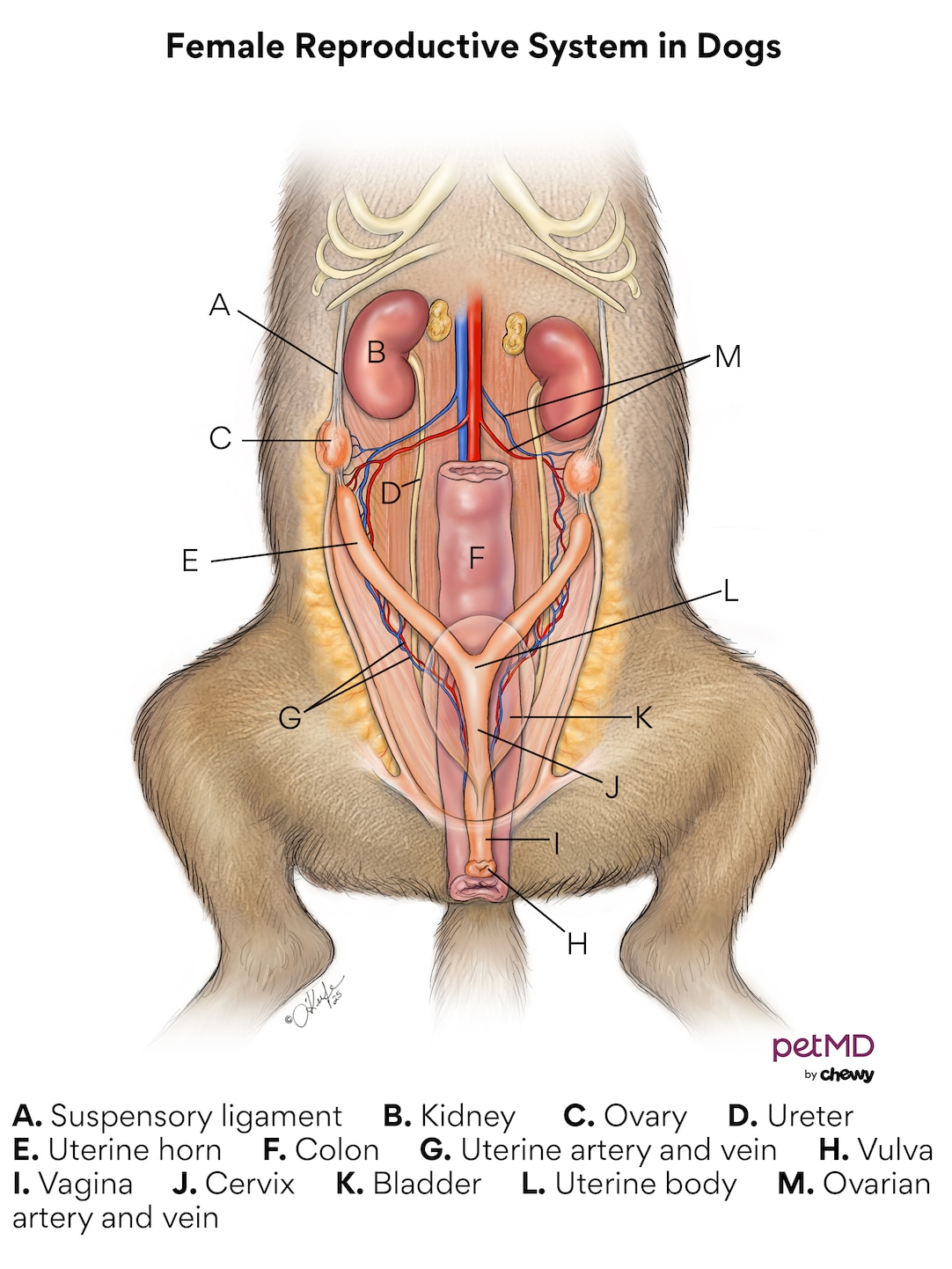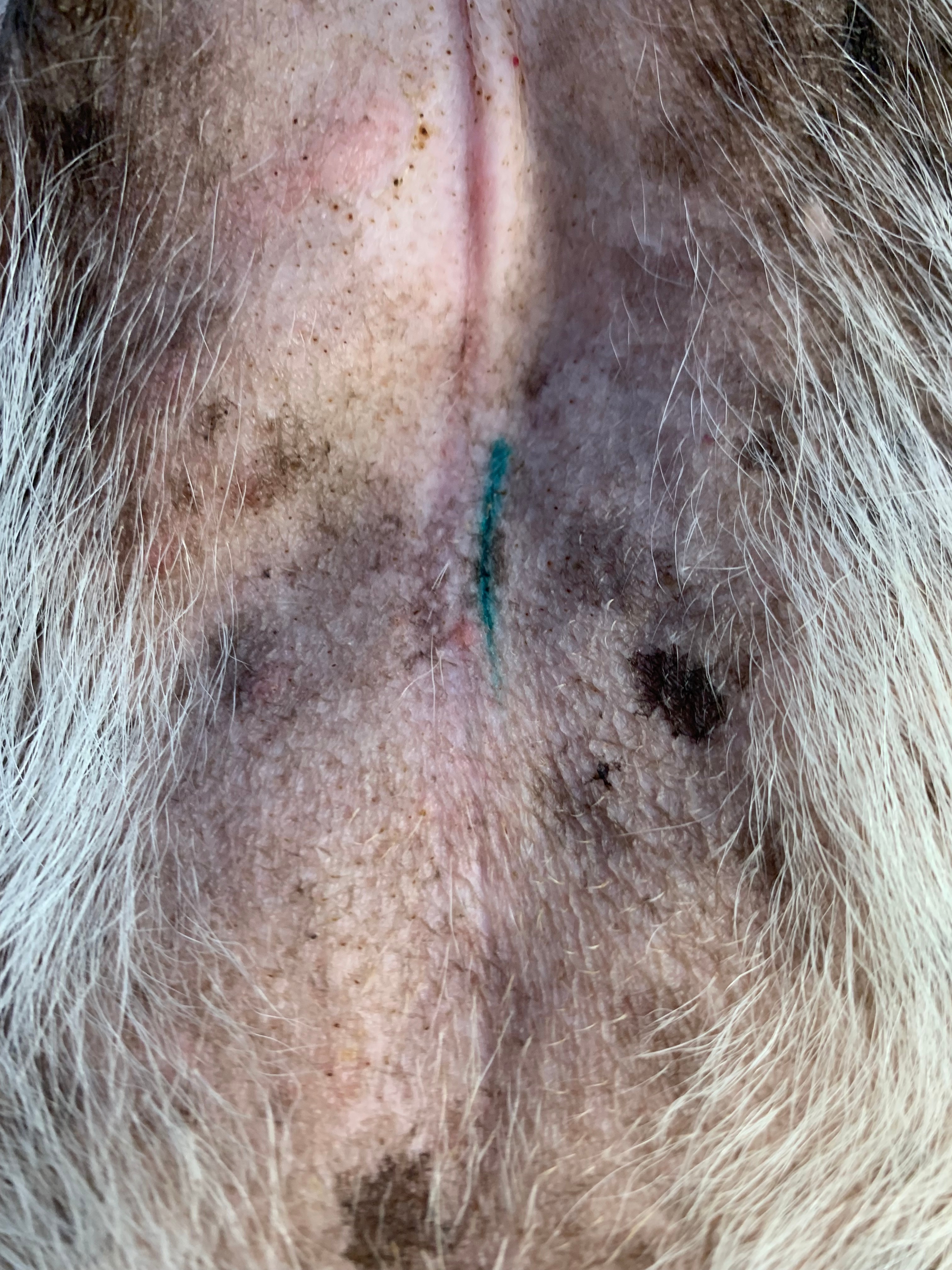Dog Spay Surgery: What It Is and What To Expect
eclipse_images/E+ via Getty Images
What Is Dog Spay Surgery?
Dog spay surgery is one of the most common veterinary surgeries performed.
Also known as ovariohysterectomy, spaying a dog involves the surgical removal of the female reproductive organs (ovaries, uterine tubes, and uterus). These organs provide hormones related to the heat cycle and behavior.

Click here to download this medical illustration.
Alternatively, some veterinarians only remove the ovaries (ovariectomy), but the results and goals of the surgery remain the same.
Even though it's a common surgery, spaying has surgical and anesthetic risks, and a certain level of care is needed in the recovery period, which typically lasts 14 days.
Anatomy of the Female Reproductive System in Dogs
A female dog’s reproductive system has an external opening, the vulva, which is connected to the vagina that in turn connects to the uterus via the cervix.
The ovaries are connected to the uterus via the uterine tubes (fallopian tubes).
Ovaries produce female hormones such as estrogen and progesterone, as well as release the eggs that travel through the uterine tubes to reach the uterus, where fertilized eggs grow into pups.
The mammary glands are also part of the female reproductive system. There are typically five pairs on the abdomen running from below the armpits to the groin. They make milk for the newly born pups.
During dog spay surgery, only the ovaries, uterine tube, and uterus are removed.
A cut (incision) is first made in the middle of the abdominal skin in between the mammary glands and then extended past the subcutaneous (fat) layer and through the abdomen.

Click here to download this medical illustration.
The ovaries and uterus are found, ligated (tied off), and removed, and then the abdomen is closed in reverse order.
Why Would a Dog Need Spay Surgery?
Most veterinarians recommend dog spay surgery as a way to prevent future life-threatening medical problems like pyometra, ovarian and uterine cancer, torsion, or cysts from happening.
Other reasons why a dog would be spayed include:
-
To prevent pregnancy, false pregnancy, and the heat cycle, including behaviors associated with heat and mating
-
To reduce risk of future complications like mammary cancer
-
Vaginal prolapse or prevention of it
-
To prevent passing on genetic or inherited conditions
-
To stabilize certain endocrine disorders like diabetes mellitus or Cushing’s disease
Benefits of Dog Spay Surgery
Dog spay surgery is a cost-effective procedure, as the costs of spaying are far less than the cost of treatment needed for a uterine problem like pyometra (which would typically include an ovariohysterectomy) or costs of having and caring for a litter.
However, there are other benefits of spaying your dog, such as:
-
No longer contributing to pet overpopulation problem
-
Alleviating the risk of unwanted or uncared-for pets by stopping the heat cycle and preventing pregnancy
-
Preventing disease
-
Decreasing roaming behavior
-
Increasing life expectancy
Effectiveness of Dog Spay Surgery
The benefits of having your dog spayed outweigh the risks, and the procedure itself is highly effective when done without complication.
Ovarian remnant syndrome is a rare condition that can happen when ovarian tissue that is unknowingly left behind regrows and starts producing hormones.
This often needs additional testing to confirm through ultrasound or blood testing, and a secondary surgery must be done to remove it.
Cost of Dog Spay Surgery
The cost of dog spay surgery varies, and some counties and organizations, such as the Humane Society, offer free vouchers or discounted spay fees.
Veterinary practices may charge anywhere from $250 to $600 or more depending on the size and age of the dog.
Some practices may have additional fees if your dog is overweight or in heat at the time of spay because of the increased risks and time spent performing the procedure.
If your dog is overweight, your vet may recommend they lose weight before surgery to reduce the chance of complications.
Preparation for Dog Spay Surgery
The day before surgery, you will be asked not to feed your dog the day before surgery or overnight, and to arrive at the hospital early in the morning. A dog may be allowed water until the morning of surgery.
After the paperwork is filled out, your dog will be hospitalized, have her blood drawn, and have an IV catheter placed.
The benefits of having your dog spayed outweigh the risks, and the procedure itself is highly effective when done without complication.
The veterinarian will perform a thorough exam, review your dog’s records and blood work, and create an anesthetic plan that’s a good fit for her.
The vet will then proceed with pain medication and sedatives to help with general anesthesia, which is used to keep your dog unconscious and pain-free during the surgery.
An endotracheal tube will be placed so that her breathing can be watched, and she will be shaved and sterilely prepped. Don’t be alarmed if she has a lot of hair removed!

Click here to download this medical illustration.
Some veterinarians tattoo all neutered or spayed pets, so your furry companion may have this done during her spay.

Complications of Dog Spay Surgery
Dog spay surgery is a major surgical procedure, but as one of the most commonly performed procedures, it carries a low risk and death rate. It’s been estimated that about 20% of dogs can experience some form of complication, with the most common being hemorrhage (bleeding).
Fortunately, bleeding problems are usually cleared up during the procedure without any long-term complications.
Some more serious but uncommon complications include:
-
Infection and wound dehiscence (breaking of the stitches and opening of the cut)
-
Seroma (fluid-filled swelling at the incision site)
-
Complications from foreign objects left inside the body (gossypiboma)
-
Ovarian remnant syndrome and/or stump pyometra
-
Uterovaginal fistula and related incontinence
-
Accidental tying off/closure of ureter (tube that carries urine)
-
Anesthetic-related complications
-
Death
Post-Op Care and Recovery for Dog Spay Surgery
Just as you would follow the pre-operative instructions from your vet, be sure to follow the post-operative, or after-care, instructions.
These instructions usually include a two-week confinement period of limited exercise, with no jumping, running, or rough play with others.
If your dog is active, these behaviors can lead to opening of the incision, bleeding, infection, and bruising and your dog could need more treatment.
A suitable resting place may include a crate she is already used to (such as this wire crate) padded with comfortable bedding, or a small room closed off with a gate.
Additionally, make sure she is not bathed during this time and that her incision site doesn’t become wet.
Some hospitals will keep your dog under observation for the evening, but most will discharge them the same day.
It’s recommended that you do not leave your dog unattended for at least the first 24 hours after surgery.
Her first night home is typically spent resting, and she will probably be groggy from the anesthesia.
She may be nauseated after surgery, so offering a small amount of water at first when she gets home is best. Offer about 1/4 to 1/2 of the normal amount of food the first evening.
Keep your dog’s diet the same during this time of stress: don’t change it or add supplements, and avoid human food. Except for the amount the first day, her diet should remain normal.
Your vet will send home additional pain medications like gabapentin or tramadol as well as an anti-inflammatory medication such as carprofen, deracoxib, or meloxicam.
Give all medications as directed by your veterinarian. Do not give your pup any human or over-the-counter pain medications.
Dogs often rebound quickly after such a procedure, but giving pain relief helps the healing process and improves recovery.
Dogs that have been spayed are rarely sent home with antibiotics. Even though it is a bit uncomfortable for your dog, wearing a recovery collar (such as this Comfy Cone™) is the best way to protect her incision and allow it to heal without complications.
Keep your dog from licking or chewing at the incision site—it only takes a few seconds for infection or self-trauma to occur!
Properly fitted, the collar should allow you to fit a couple of fingers through at the base and should extend past her nose.
A recovery suit or similar clothing is another way to protect the incision and provide comfort, but it should be kept clean and routinely laundered.
Do not remove the recovery cone or surgical suit unless your dog is supervised.
Incision care usually means checking the incision site at least once a day. The incision itself should look like a line on the abdomen that may have a little bit of crusting or dried blood.
Make sure it is clean and dry.
Cleaning the wound is usually not needed. Don’t apply any topical ointments, sprays, or salves without first asking your veterinarian.
Note any changes in appearance that could be a sign of infection, such as:
-
Redness or changes in color
-
Any type of discharge: clear, red (bloody), white (pus), or mixture
-
Odor
-
Swelling
-
Heat
-
Tenderness upon touch
-
Excessive bruising: mild bruising may be noted at first but should improve daily
-
Loose or missing stitches/staples
-
Puckering or gaping of the incision
External stitches are rarely used, and most cases do not need bandaging. However, if stitches are present, they usually are removed in two weeks.
Alternatives to Dog Spay Surgery
Given the reasons why a dog would be spayed, unfortunately, there is no other good alternative to dog spay surgery.
The options available to prevent a dog’s heat cycle are extremely limited.
Dog Spay Surgery FAQs
What is the best age to spay a female dog?
The best timeframe to spay a dog is highly debated and continually reviewed by the veterinary community.
Most veterinarians recommend spaying before your dog has her first heat cycle, usually around the age of puberty, or 6 to 9 months old. However, speak with your veterinarian about the best time for your dog.
Do dogs change after being spayed?
Spaying your dog involves the removal of her reproductive organs and hormones.
Because these hormones can influence other parts of her growth and behavior, there may be some changes, such as a tendency to become overweight.
But generally, her behavior and personality remain relatively unchanged.
References
Burrow R, Batchelor D, Cripps P. Complications observed during and after ovariohysterectomy. Veterinary Record, 2005;157(26):829–833.
How Much Does It Cost to Spay a Dog? Forbes Advisor. Updated Jan. 3, 2024.
Spaying and Neutering May Lead to Longer Lifespans. Banfield Pet Hospital. May 8, 2013.
Pearson H. The complications of ovariohysterectomy. Journal of Small Animal Practice. 1973;14(5):257–266
